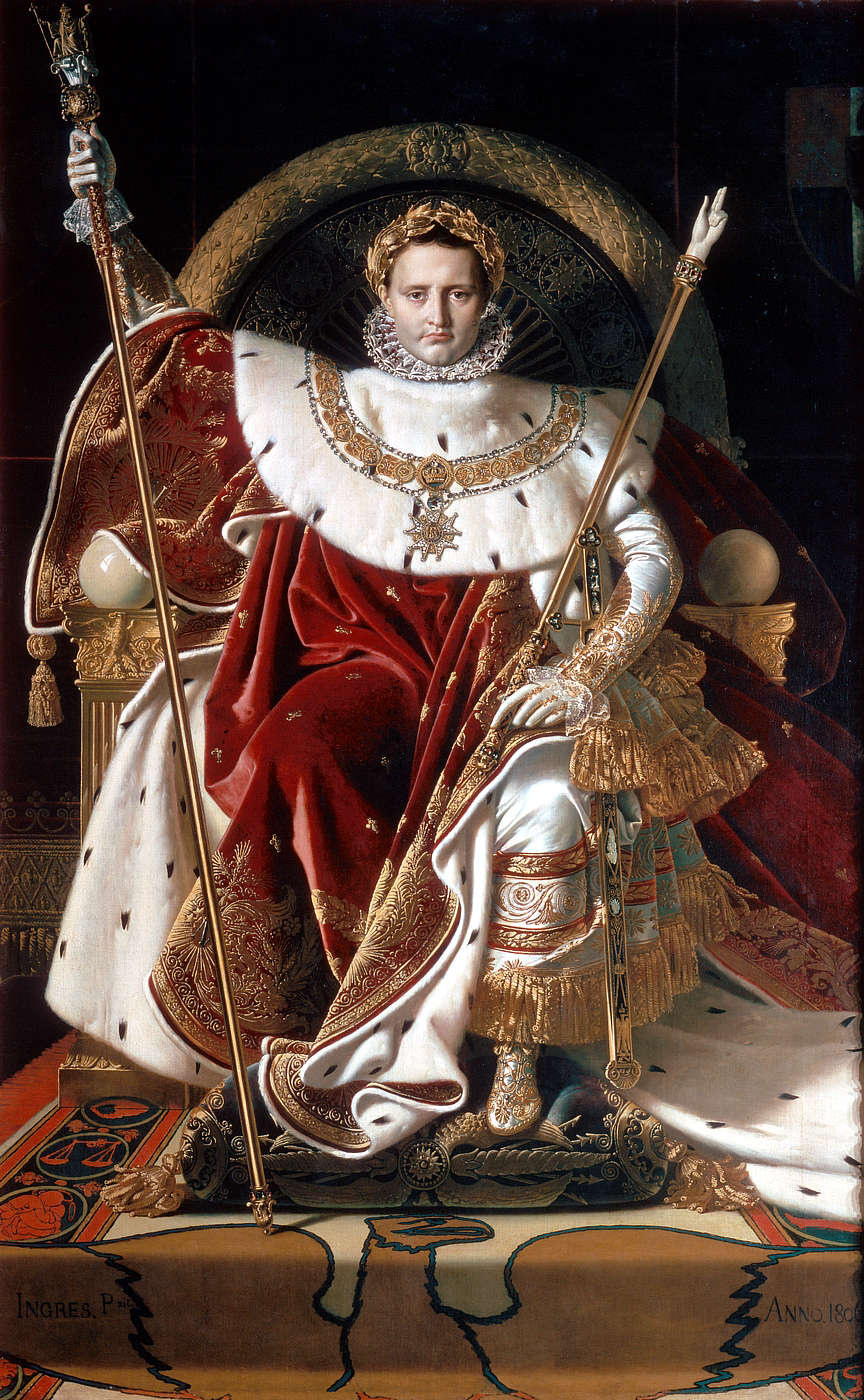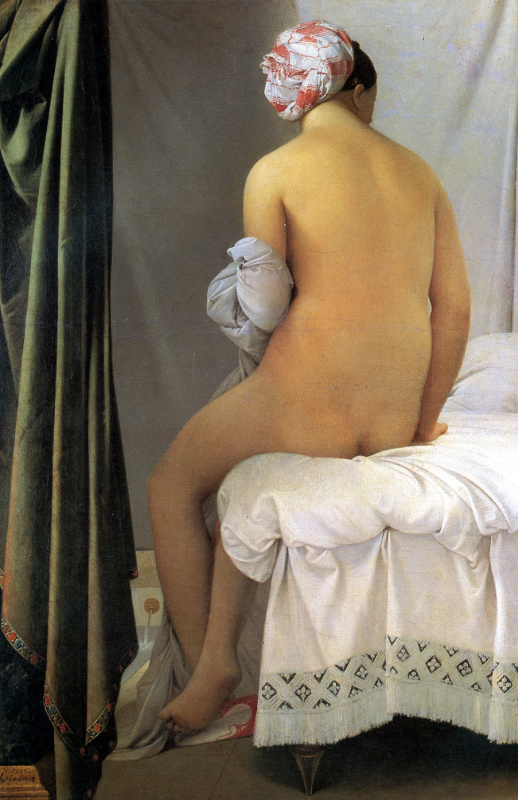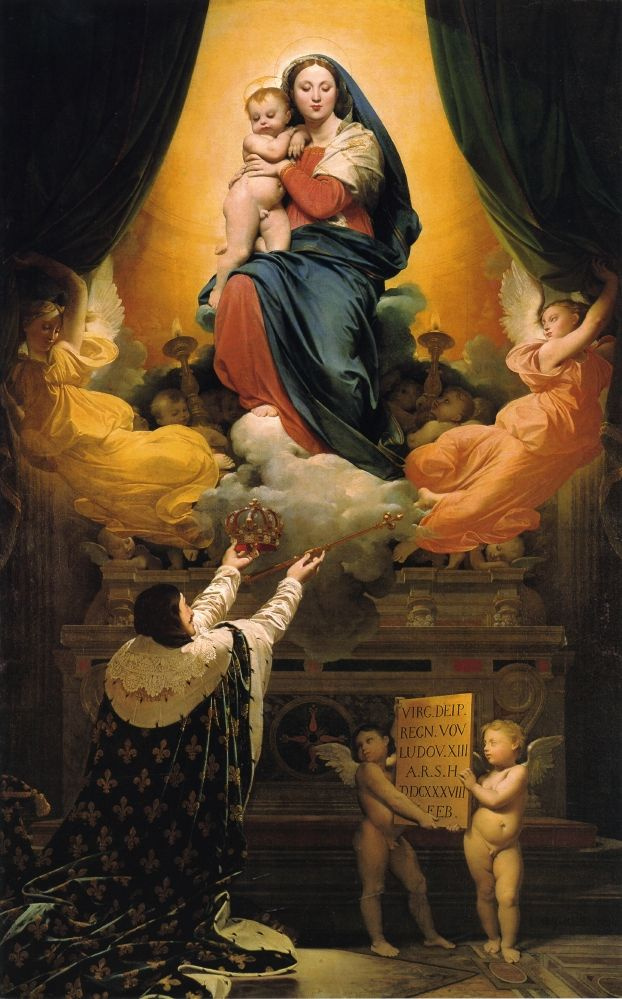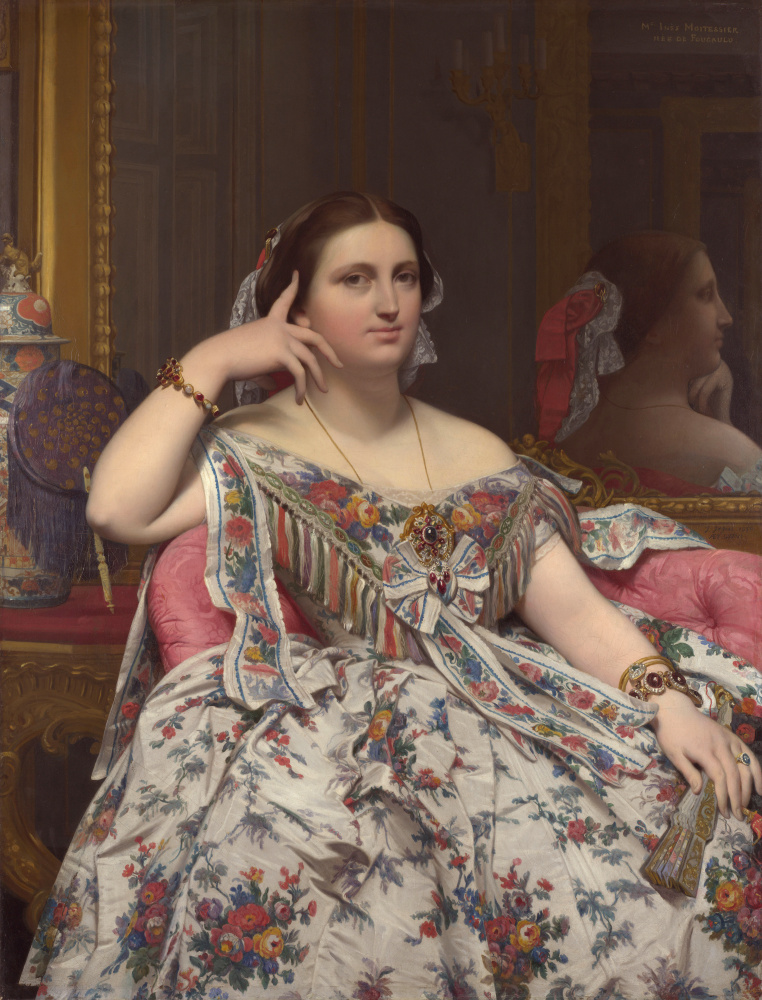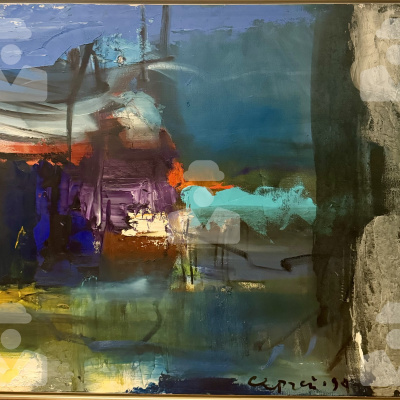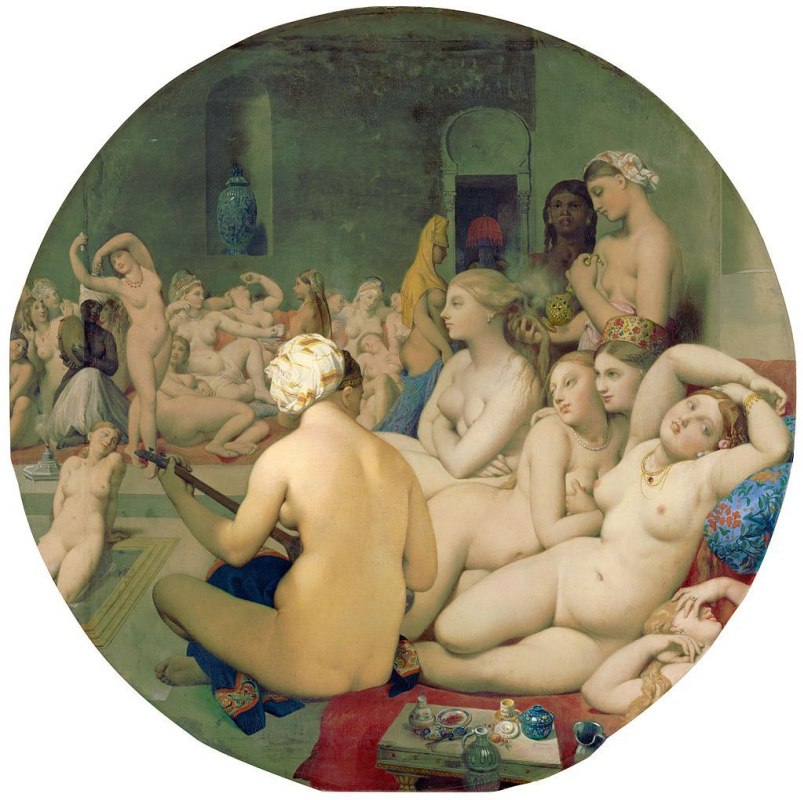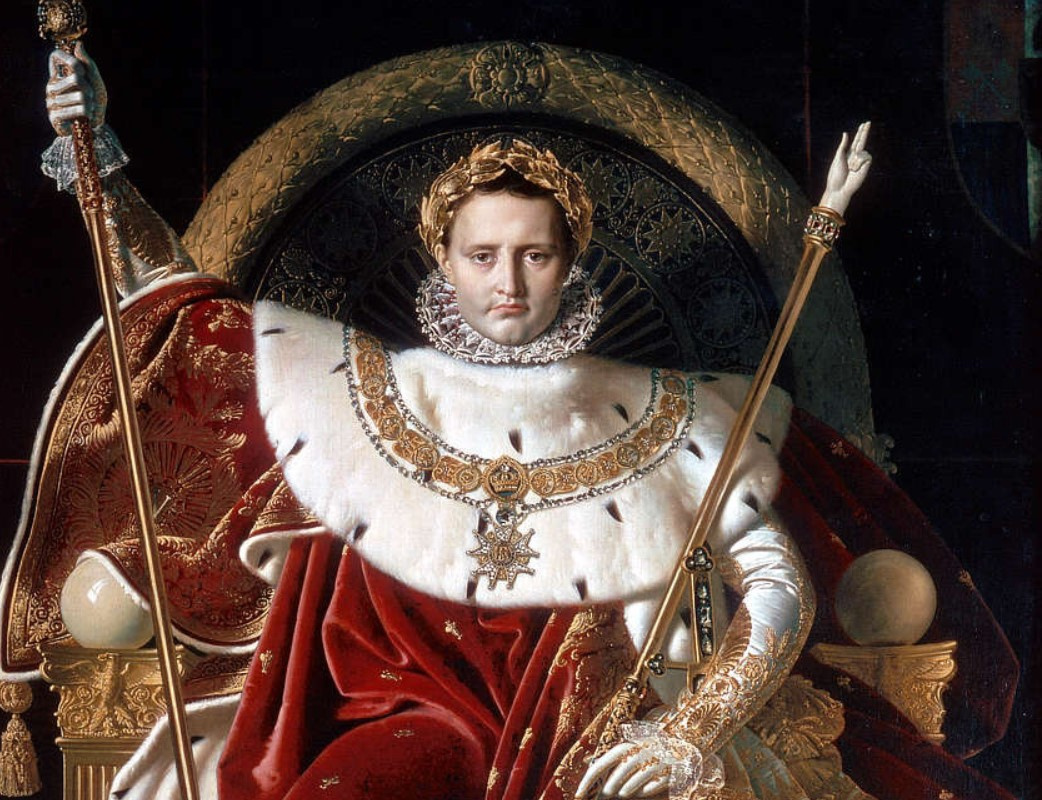
Mademoiselle Caroline Rivière, 1806
Jean-Auguste-Dominique Ingres, Mademoiselle Caroline Rivière (1806). Louvre Museum, Paris
Portraits of Caroline Rivière and her parents Philibert and Marie-Françoise form a kind of triptych, which is now in the Paris Louvre. They were painted in Paris in 1806, shortly before Ingres left for Rome. He sought to become a historical artist, but was forced to make his living by painting portraits, although he considered it a "low" occupation.
These canvases were presented at the Salon along with the Napoleon I on his Imperial Throne (we speak about him below). Critics reproached the painting with too much Gothic, drawing a parallel between the styles of Ingres and such "primitives" as Jan van Eyck, who was just being discovered then. In addition, Ingres neglected anatomical precision. Caroline’s neck is too elongated, and the nose bridge forms a strange curve with her eyebrow. At the same time, the artist skilfully emphasized the purity and youth spontaneity of his model, who was 13 to 15 years old at that time. Unfortunately, the girl died a year after the portrait was painted.
Napoleon I on his Imperial Throne, 1806
Although Ingres was a "reluctant portrait painter", he became famous, among other things, for his carefully worked images, such as the Napoleon I on the Imperial Throne. The artist portrayed his hero as a truly omnipotent person in luxurious clothes as a divine ruler, in short. This exquisite painting features the meticulous attention to detail that is characteristic of the artists of the Northern Renaissance , like the already mentioned Jan van Eyck. Even Napoleon’s pose resembles that of Jesus the Almighty on the Ghent Altarpiece.The portrait of Napoleon I on the Imperial Throne is now in the Army Museum in the Palais des Invalides in Paris.
"Don't you see that Monsieur Ingres himself wants to sit here?" with that being said, the artist Ingres got the young man in the theatre out of the place, who turned out to be the writer Anatole France. The artist was not complaisant at all…
…Everyone knows the spouse of a French official who served in Rome to introduce Ingres to his future wife. In fact, the situation was more piquant: Ingres was in love with this woman, and she wanted to console him and brought the artist to her cousin, who was very similar to her.
Big Bather (Walpinson’s Bather)
Ingres spent a significant part of his life between France, where he was born and raised, and Italy, where he first came for an internship at the age of 26. There he painted his Walpinson’s Bather, which he sent to the Paris Academy of Fine Arts as a report on his studies.Jean-Auguste-Dominique Ingres. Big Bather (Walpinson's Bather), 1808. Louvre Museum, Paris
This piece marks his departure from artistic tradition for two reasons. Firstly, it is nude in the genre of everyday life (some people generally call the Bather the first canvas within the genre, on which nudity appeared). Secondly, a touch of exoticism is clearly visible in the work. We see a naked woman from her back, sitting on the bed. Her face is almost hidden, making one wonder how she looks and what she feels, and her hair is tucked under her kerchief.
Jupiter and Thetis, 1811
This painting was also painted during his internship in Rome in 1811. It illustrates a mythological plot from Homer’s Iliad. The nymph Thetis begs the powerful Zeus (Jupiter) to help her son Achilles, who was participating in the Trojan War. This is a very emotional episode: the whole position of the supplicant’s body and the expression on her face convey suffering, in sharp contrast to the dark, powerful figure of the god, whose gaze is fixed on the distance. He doesn’t even seem to hear the nymph.Now the canvas is included in the collection of the Granet Museum in Aix-en-Provence.
Grande Odalisque, 1814
Undoubtedly, this is the most famous nude among Ingres’s works, it can now be seen in the Louvre. Just as Walpinson’s Bather, it represents a beautiful woman lying on luxurious fabrics with her back to the viewer. In 1819, the work was removed from the Salon due to an "anatomical discrepancy": the arm was too long and too flexible, and there were clearly several extra vertebrae in the back.Raphael and La Fornarina, 1814
This composition is the first of six versions, it reflects the concept of Ingres’s creativity, who considered the works by Raphael the pinnacle of painting achievements. Here the artist presented his idol’s love for the woman who was known as "La Fornarina" ("Little Baker"). According to the biographer Giorgio Vasari, their relationship led to the death of the young genius due to excessive lovemaking.Initially, Ingres planned to create a series of paintings depicting episodes from the life of the Renaissance artist, but finished only two (the second is The Betrothal of Raphael and the Niece of Cardinal Bibbiena). Now Raphael and La Fornarina is included in the collection of Harvard museums.
The Vow of Louis XIII, 1824
Inspired by the work of Raphael, Ingres painted religious works like The Vow of Louis XIII. This painting was commissioned by the French Ministry of the Interior for the Notre Dame Cathedral in Montauban, where it is kept till this day. This is an allegory of the unification of church and state: Louis XIII on his knees dedicates his kingdom to the Virgin Mary and the Child Jesus, who gaze at him from heaven.The Virgin Adoring the Host, 1841
Although 17 years have passed between The Vow of Louis XIII and The Virgin Adoring the Host, there is a noticeable similarity in these paintings. Firstly, the almost identical poses of the Virgin Mary, and secondly, the powerful influence of Raphael and Renaissance artists are striking here.Jean-Auguste-Dominique Ingres. The Virgin Adoring the Host (1841). The Pushkin State Museum of Fine Arts, Moscow
The painting was commissioned by the heir to the Russian throne, the future Emperor Alexander II. He wished that Saint Nicholas, the patron saint of his father, was depicted on the left behind the Madonna, and his own patron, Saint Alexander Nevsky, on the right. However, in Russia, the masterpiece was accepted with restraint. Perhaps it was in his frankly Catholic tradition of painting, or maybe in the cold aloofness of the Virgin.
Now this canvas is one of two works by Ingres that are stored in Russian collections. It is located in the Moscow Pushkin Museum. The second is the Portrait of Count Guriev, it is exhibited in the Hermitage.
Portrait of the Duchess de Broglie, 1853
The portrait of Pauline de Broglie was Ingres’s last commission. He painted this masterpiece about the end of his life, when his reputation as a portrait painter had long been established among prominent townspeople and Orleanist aristocrats. The artist captured the shy restraint of his sitter, while emphasizing the quality of her many beautiful attributes: the rich blue satin laced ball gown, the shawl embroidered with gold, an armchair upholstered in damask silk, and fine jewellery.Madame Moitessier, 1856
Although this work was completed after the aforementioned portrait, it had been commissioned earlier in 1844, for the second wedding anniversary of Marie-Clotilde-Inès de Foucauld and a wealthy entrepreneur Sigisbert Moitessier. At first, Ingres did not want to take on the painting, but he changed his mind when he met 23-year-old Madame Moitessier and found her very beautiful. It’s good that he changed his mind, because this portrait is considered the best in his work.It took the artist 12 years to create it, and during this time the painting has undergone several major transformations. Initially, it was supposed to include the daughter of the clients, but Ingres was annoyed by the restlessness of the little model. Moreover, a different dress was chosen to reflect the fashion trends.
The Source, 1856
Jean-Auguste-Dominique Ingres, The Source (1856). Louvre Museum, Paris
Ingres began this work in Florence around 1820, and completed 36 years later, when he was already well over 70. As a true neoclassicist, he was inspired by the famous antique statues of Aphrodite of Cnidus and Venus the Shy. The pose of the heroine of The Source is identical to that of the model in his Venus Anadyomene painting. The vessel with water and the background of the canvas were painted by two of the artist’s students, and Ingres’s signature can be seen on the stone in the lower left corner.
This is certainly one of his most famous works. Art critics of that time admired the artist’s desire to create a figure of ideal beauty. Théophile Gaultier wrote: "Never before has chaste nakedness appeared to the viewer so soft, so young, so imbued with light, so full of life. Here the ideal came through illusion." In the house of its first owner, Count Duchâtel, the painting was "framed by large plants and water flowers, so that the nymph of spring looked even more like a real person".







